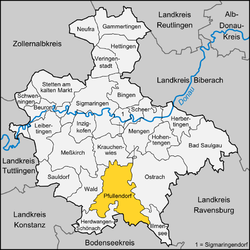Pfullendorf
| Pfullendorf | ||
|---|---|---|
|
||
| Coordinates: 47°55′27″N 9°15′24″E / 47.92417°N 9.25667°ECoordinates: 47°55′27″N 9°15′24″E / 47.92417°N 9.25667°E | ||
| Country | Germany | |
| State | Baden-Württemberg | |
| Admin. region | Tübingen | |
| District | Sigmaringen | |
| Government | ||
| • Mayor | Thomas Kugler | |
| Area | ||
| • Total | 90.56 km2 (34.97 sq mi) | |
| Population (2015-12-31) | ||
| • Total | 13,104 | |
| • Density | 140/km2 (370/sq mi) | |
| Time zone | CET/CEST (UTC+1/+2) | |
| Postal codes | 88630 | |
| Dialling codes | 07552 | |
| Vehicle registration | SIG | |
| Website | www.pfullendorf.de | |
| Imperial City of Pfullendorf | ||||||||||
| Reichsstadt Pfullendorf | ||||||||||
| Free Imperial City of the Holy Roman Empire | ||||||||||
|
||||||||||
| Capital | Pfullendorf | |||||||||
| Government | Republic | |||||||||
| Historical era | Middle Ages | |||||||||
| • | Imperial immediacy | June 2, 1220 | ||||||||
| • | Establishment of guild constitution | 1383 | ||||||||
| • | Granted Hochgerichtsbarkeit | 1415 | ||||||||
| • | Mediatised to Baden | 1803 | ||||||||
|
||||||||||
Pfullendorf is a small town of about 13,000 inhabitants located 25 km (16 mi) north of Lake Constance in Baden-Württemberg, Germany. It was a Free Imperial City for nearly 600 years.
The town is in the district of Sigmaringen south of the Danube valley and therefore on the continental divide between the watersheds of the Rhine and the Danube. The area is known as the Linzgau.
Pfullendorf was founded by the Alamanni tribe during their third wave of settlement and might have been named after a clan chief named Pfullo. According to another theory, it was named Dorf am Phoul (Pfuol), meaning village on the Phoul.
The area around Lake Constance, particularly the Linzgau, Hegau and Vorarlberg, came progressively under the rule of the counts of Pfullendorf from the 8th century onward. The earliest documented bearer of that name was Count Ludwig von Pfullendorf, who is referred to as the ruler of the county of Hegau from 1067 to 1116. Presumably, Pfullendorf expanded due to its proximity to the counts' castle. Count Rudolf, a partisan of the future Emperor Frederick I Barbarossa, was able to expand his family's possessions and they eventually owned fiefs from the Danube to the Grisons. Following the death of his son Berthold in 1167, Count Rudolf named the Emperor as his heir and then moved to the Holy Land where he died in 1181.
In June 1220, Emperor Frederick II elevated Pfullendorf to the status of Imperial City. However, the prince-bishops of Constance, as the biggest landowners in the Linzgau and patrons of several religious institutions such as Holy Spirit Hospital in Pfullendorf, continued to exert significant political influence over the whole area. At the Council of Constance (1415), King Sigismund granted Blutgerichtsbarkeit ("Blood justice" or the right to pronounce sentences of death or mutilation) to the town, a status that confirmed the city as being answerable to God and to the Emperor only.
Starting in 1383, Pfullendorf ruled itself according to a constitution that gave decisive powers to the town guilds and provided for the annual election of the mayor. A 50-member “High Council” also elected annually, was vested with executive authority alongside a 17-member “Small Council” chaired by the mayor. With brief interruptions, this guild-based constitution remained in force until 1803 and was to serve as a model for other cities.
...
Wikipedia



